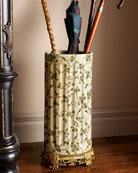
History: Breuer was an apprentice at the Bauhaus in 1925 when he came up with the design idea for this chair. The frame was inspired by the tubular frame of a bicycle and it was revolutionary in the use of the materials (bent tubular steel and canvas) and methods of manufacturing. It is now considered one of the most iconic chairs of the 20th Century.

History: Le Corbusier designed this for the Salon d'Automne installation, Equipment for the Home in 1929 in Paris. The "Grand Confort," armchair has a chrome-plated tubular steel frame and the five voluminous, orthogonal leather cushions, evoking both comfort and formal reduction.

History: Commissioned exclusively for the German pavilion at the World Exposition in Barcelona, Spain, it was designed to be used by the King and Queen of Spain during the opening ceremony. The architect looked for inspiration to the throne-like form of the curule chair, a stool used by senior Roman magistrates, translating an ancient and regal design into a modern setting.

History: The Bibendum chair remains unique in the sense that no one else has produced a chair quite like it. A striking combination of slender steel and voluptuous leather-clad curves, the sumptuous Bibendum was designed for comfort. While highly regarded by many as a leading designer of her time, Gray did not receive widespread recognition until she was in her nineties, and the iconic chair – inspired by Michelin's mascot Bibendum Man – was largely forgotten about until it reappeared nearly 40 years later, prompting a new production of this design classic.
Her Story: I would totally annoy people by saying Bibendum a meeellion times a day if I had one of these...."I left it on the bibendum"...."no, you take the bibendum, I'll be fine on the sofa"...

History: Bertoia’s Bird chair resulted from a 1950 experiment with bending metal rods into practical art. Innovative, comfortable and strikingly handsome, the chair’s delicate filigree appearance belies its strength and durability. In Bertoia’s own words, “If you look at these chairs, they are mainly made of air, like sculpture. Space passes through them.”

History: The culmination of Charles and Ray Eames' efforts to create a club chair using the molded plywood technology that they pioneered in the '40s. In Charles Eames' words, the vision was a chair with the "warm, receptive look of a well-used first baseman's mitt." The result has become the consummate lounge set, timelessly blending old-fashioned comfort and visionary modernism.
8. The Egg chair, Arne Jacobsen, 1958

History: Designed exclusively for the Radisson SAS hotel in Copenhagen and made a memorable appearance in Stanley Kubrick’s 2001: A Space Odyssey. Jacobsen had a passion for modernism and his love for Scandinavian simplicity gave birth to some of the most recognizable chairs in the design world - the Series 7 chair and the Swan chair.

History: From the moment this chair was presented to Vitra it was intended for mass production. The first models were made from fiberglass-reinforced polyester but later versions were made in hard-foamed polyurethane. Vitra makes these now in injection-molded polypropylene, which is UV and weatherproof and can be used both indoors and outdoors. Panton’s other famous designs - the Cone chair and the Flying chair.

History: Designed for Lapalma, Shin and Tomoko Azumi's LEM Piston Stool reveals rigorous and original rethinking of the form and function of seating. The LEM Piston Stool's sculptural leather, stainless steel or beech wood seat not only swivels, but also adjusts easily from a counter height (26.5") to a bar height (31") with a lever that activates a gas cylinder. While utility strongly determines the form of this unique stool, it also has a visual lightness that creates the illusion of freedom from gravity.
Her Story: Four of these lining my kitchen island...perfection!








 es does this happen to you? You order a bed from Pottery Barn along with all the linen and accessories and it doesn't quite look like you imagined it. What if you painted the walls in the exact shade that the catalog staged it? Well, Benjamin Moore has teamed up with Pottery Barn and now they provide the paint colors used right in the catalog. How cool is that!
es does this happen to you? You order a bed from Pottery Barn along with all the linen and accessories and it doesn't quite look like you imagined it. What if you painted the walls in the exact shade that the catalog staged it? Well, Benjamin Moore has teamed up with Pottery Barn and now they provide the paint colors used right in the catalog. How cool is that!





 This one is from Aleesi: The Blow Up Umbrella Stand
This one is from Aleesi: The Blow Up Umbrella Stand
